Difference between revisions of "Olive leather"
| (3 intermediate revisions by one user not shown) | |||
| Line 5: | Line 5: | ||
<p align=center> | <p align=center> | ||
| − | [[bild:Olivenbaum-01.jpg| | + | [[bild:Olivenbaum-01.jpg|500px]] |
| − | + | ||
</p> | </p> | ||
| Line 12: | Line 11: | ||
==Olive leather - Wet-Green - O'leaf tan== | ==Olive leather - Wet-Green - O'leaf tan== | ||
"Olive leather" and "Wet-Green" are registered trademarks. The [[tanning leather|tanning process]] is patented and protected by the brand "[http://www.wet-green.com/ Wet-Green]". It is also marketed as "O'leaf tan". | "Olive leather" and "Wet-Green" are registered trademarks. The [[tanning leather|tanning process]] is patented and protected by the brand "[http://www.wet-green.com/ Wet-Green]". It is also marketed as "O'leaf tan". | ||
| + | |||
| + | |||
| + | <p align=center> | ||
| + | [[bild:Olive-leather-olive-tanning.jpg|500px]] | ||
| + | </p> | ||
| + | |||
Olive [[leather]] is tanned with [[tannins]] made of olive leaves. Extracts with a tanning effect are obtained from the leaves by extraction and evaporation. The tannin is in liquid form. Olive leather is generally [[Chrome tanned#Chrome-free leather - FOC = Free of Chrome|free of chromium]], but is [[tanning leather|re-tanned]] [[Synthetic tanned|synthetically]] or by using a [[Vegetable-tanned leather|vegetable tanning method]] | Olive [[leather]] is tanned with [[tannins]] made of olive leaves. Extracts with a tanning effect are obtained from the leaves by extraction and evaporation. The tannin is in liquid form. Olive leather is generally [[Chrome tanned#Chrome-free leather - FOC = Free of Chrome|free of chromium]], but is [[tanning leather|re-tanned]] [[Synthetic tanned|synthetically]] or by using a [[Vegetable-tanned leather|vegetable tanning method]] | ||
| + | |||
| + | |||
| + | <p align=center> | ||
| + | [[bild:Olivenbaum-02.jpg|500px]] | ||
| + | </p> | ||
| + | |||
So far, olive tree leaves have not been used economically. 12 of the 15 million tons of olives harvested annually come from Europe. In Europe, approximately 1 million tonnes of olive leaves and 30 million tonnes of olive residues are produced annually. Enough for the tanning of approximately 600 million square meters of leather, which would be about 40% of [[leather industry|world production]]. So far, these residues have been burned. | So far, olive tree leaves have not been used economically. 12 of the 15 million tons of olives harvested annually come from Europe. In Europe, approximately 1 million tonnes of olive leaves and 30 million tonnes of olive residues are produced annually. Enough for the tanning of approximately 600 million square meters of leather, which would be about 40% of [[leather industry|world production]]. So far, these residues have been burned. | ||
| Line 21: | Line 32: | ||
<p align=center> | <p align=center> | ||
| − | [[bild:Olivenleder-Anilin-01.jpg| | + | [[bild:Olivenleder-Anilin-01.jpg|500px]] |
| − | [[bild:Olivenleder-Vintage-01.jpg| | + | </p> |
| + | <p align=center> | ||
| + | [[bild:Olivenleder-Vintage-01.jpg|500px]] | ||
</p> | </p> | ||
<p align=center> | <p align=center> | ||
| Line 29: | Line 42: | ||
<p align=center> | <p align=center> | ||
| − | [[bild:Olivenleder-Nappa-01.jpg| | + | [[bild:Olivenleder-Nappa-01.jpg|500px]] |
| − | [[bild:Olivenleder-Praegung-01.jpg| | + | </p> |
| + | <p align=center> | ||
| + | [[bild:Olivenleder-Praegung-01.jpg|500px]] | ||
</p> | </p> | ||
<p align=center> | <p align=center> | ||
| Line 37: | Line 52: | ||
In 2012, olive leather was presented to the market. In 2013 it was already processed for [[leather shoes|shoe leather]], [[leather clothing|clothing leather]], [[leather bag|bag leather]], [[leather furniture|furniture leather]] and [[car leather]]. In 2013, olive leather was used as a [[finish|pigmented]] variant in the BMW i3. Also in 2020, the BMW i3 Urban Suite models had a leather interior with olive tanning. | In 2012, olive leather was presented to the market. In 2013 it was already processed for [[leather shoes|shoe leather]], [[leather clothing|clothing leather]], [[leather bag|bag leather]], [[leather furniture|furniture leather]] and [[car leather]]. In 2013, olive leather was used as a [[finish|pigmented]] variant in the BMW i3. Also in 2020, the BMW i3 Urban Suite models had a leather interior with olive tanning. | ||
| + | |||
| + | From a chemical point of view, the [[Tannins|tanning agent]] obtained from olive leaves is a natural masked glutaraldehyde and the tanning is more like a [[Synthetic tanned|synthetic tanning]]. | ||
| Line 43: | Line 60: | ||
</p> | </p> | ||
<p align=center> | <p align=center> | ||
| − | ''The olive-tanned and still wet leather is also called "Wet-Green" like the "[[ | + | ''The olive-tanned and still wet leather is also called "Wet-Green" like the "[[wet white]]" and the "[[wet blue]]".''<br></p> |
<p> </p> | <p> </p> | ||
| − | < | + | <p align=center> |
| − | + | [[bild:Horse Leather Leather Bag.jpg|500px]] | |
| + | </p> | ||
| + | <p align=center> | ||
| + | ''[[Horsehide - Horse leather|Horse leather]] bag olive tanned as a beautiful natural product (seen at [http://www.leder-fiedler.de/ www.leder-fiedler.de]).''<br></p> | ||
| + | <p> </p> | ||
== Additional information == | == Additional information == | ||
Latest revision as of 19:41, 23 May 2023
Olive leather - Wet-Green - O'leaf tan
"Olive leather" and "Wet-Green" are registered trademarks. The tanning process is patented and protected by the brand "Wet-Green". It is also marketed as "O'leaf tan".
Olive leather is tanned with tannins made of olive leaves. Extracts with a tanning effect are obtained from the leaves by extraction and evaporation. The tannin is in liquid form. Olive leather is generally free of chromium, but is re-tanned synthetically or by using a vegetable tanning method
So far, olive tree leaves have not been used economically. 12 of the 15 million tons of olives harvested annually come from Europe. In Europe, approximately 1 million tonnes of olive leaves and 30 million tonnes of olive residues are produced annually. Enough for the tanning of approximately 600 million square meters of leather, which would be about 40% of world production. So far, these residues have been burned.
Olive leather is sold as aniline leather, semi-aniline leather or pigmented.
Porous, smooth olive leather. - Olive leather with vintage optics.
Finished olive napa leather and embossed pigmented olive leather. Both are processed at BMW.
In 2012, olive leather was presented to the market. In 2013 it was already processed for shoe leather, clothing leather, bag leather, furniture leather and car leather. In 2013, olive leather was used as a pigmented variant in the BMW i3. Also in 2020, the BMW i3 Urban Suite models had a leather interior with olive tanning.
From a chemical point of view, the tanning agent obtained from olive leaves is a natural masked glutaraldehyde and the tanning is more like a synthetic tanning.
The olive-tanned and still wet leather is also called "Wet-Green" like the "wet white" and the "wet blue".
Horse leather bag olive tanned as a beautiful natural product (seen at www.leder-fiedler.de).
Additional information








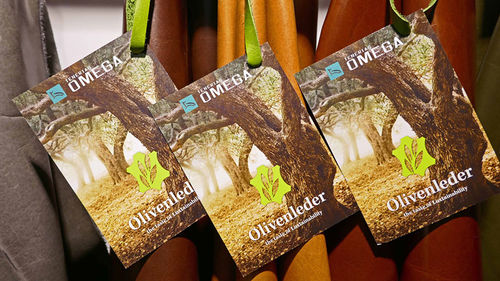
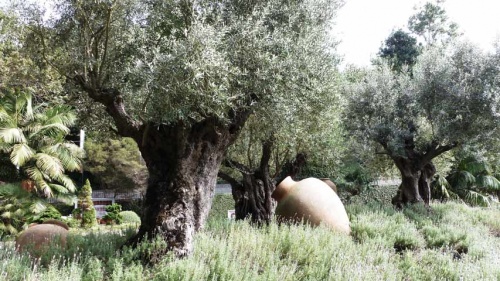
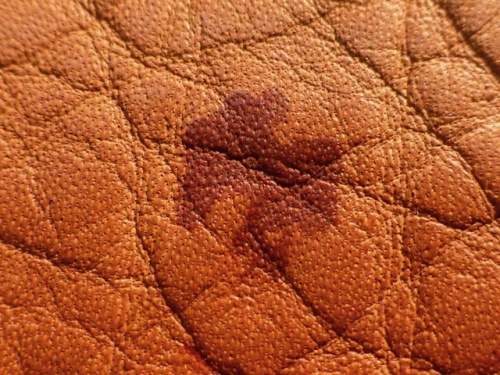
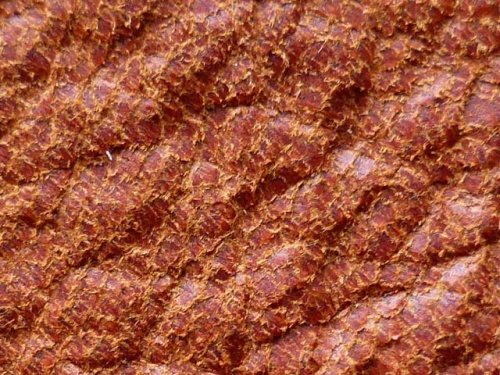
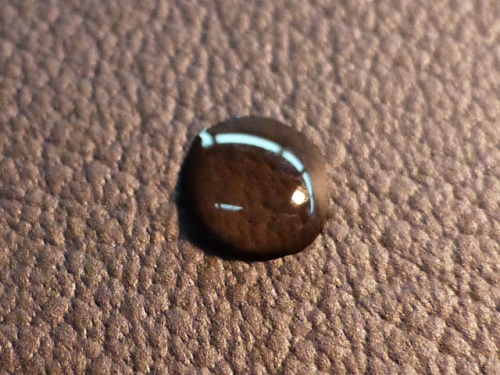
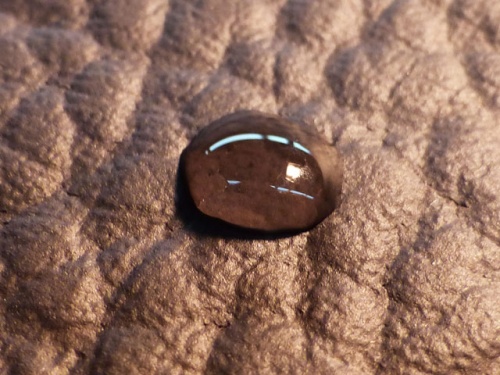
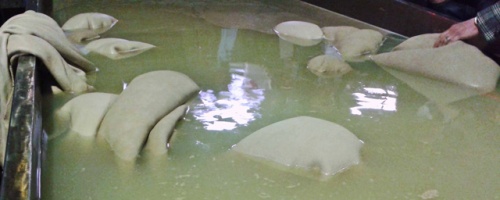
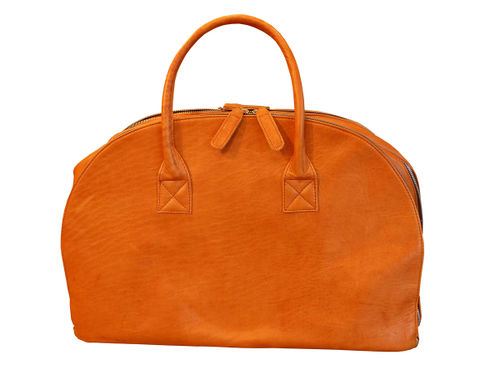

 a kotori web solution
a kotori web solution